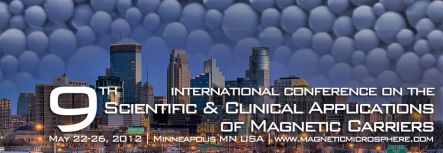

Please consider joining the LinkedIn group and/or participating, posting, or promoting your activities or the activities of others in the field on this group site. Information for the group, including how to join, can be reached at this link.
Special Issue about Pharmaceutical Nanoparticles in Pharmaceutical Research
June 09, 2012The May 2012 issue of Pharmaceutical Research is a theme issue about "Magnetic Nanoparticles for Biomedical Applications" edited by Alexander Pfeifer and Katrin Zimmermann from the Institute of Pharmacology and Toxicologie, University of Bonn; und Christian Plank from the Institute of Experimental Oncology and Therapy Research at the Technical University in Munich.
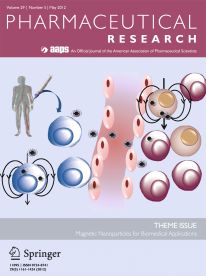 Research papers and reviews are presented that deal with MNPs in various - mostly biomedical - applications. Based on the scientific background of the guest editors, a focus of this theme issue is magnetic drug targeting, in particular magnetically guided and enhanced nucleic acid delivery, also known as magnetofection. Considerable progress in this particular field has been accomplished during the last decade. This focus is not intended to neglect the formidable achievements with magnetic particles in other biomedical applications, such as cell tracking and positioning, magnetic cell separation, imaging and diagnostics, theranostics, magnetic actuation of cellular functions, AC magnetic field hyperthermia, etc. Most contributions to this theme issue report on applications of magnetic particles as opposed to theoretical / physical considerations. However, several papers focus on chemical and physical topics implied in the preparation and imaging/detection of MNPs as well as on mathematical models to better understand the physics of magnetofection.
Research papers and reviews are presented that deal with MNPs in various - mostly biomedical - applications. Based on the scientific background of the guest editors, a focus of this theme issue is magnetic drug targeting, in particular magnetically guided and enhanced nucleic acid delivery, also known as magnetofection. Considerable progress in this particular field has been accomplished during the last decade. This focus is not intended to neglect the formidable achievements with magnetic particles in other biomedical applications, such as cell tracking and positioning, magnetic cell separation, imaging and diagnostics, theranostics, magnetic actuation of cellular functions, AC magnetic field hyperthermia, etc. Most contributions to this theme issue report on applications of magnetic particles as opposed to theoretical / physical considerations. However, several papers focus on chemical and physical topics implied in the preparation and imaging/detection of MNPs as well as on mathematical models to better understand the physics of magnetofection.
To see for yourself, see http://www.springerlink.com/
Higher Magnetic Field Frequencies Might Raise Peripheral Nerve Excitation Thresholds
June 06, 2012
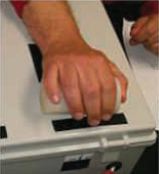
To check out if this is important for your applications and to learn more, check here.
Report from the Magnetic Carrier Meeting 2012
May 29, 2012The now already 9th International Conference on the Scientific and Clinical Applications of Magnetic Carriers from May 22-26, 2012 was again a wonderful meeting full of great science and lots of interesting talks (76 of them, 6 invited talks and a tutorial). Minneapolis, MN, USA was a perfect location, and Prof. Jian Ping Wang, our host, and his lab organized a seemless program on the beautiful University of Minnesota campus. A highlight of the meeting was the beautiful boat trip on the Mississippi.
If you wonder what all we did - just in case you would like to come to our next meeting - then please check out the details here:
- Scientific Program 2012
- Posters 2012
- BioMax Satellite Symposium 2012
Two Best Paper Awards Available for ICMF-13
May 29, 2012
The 13th International Conference on Magnetic fluids has proposed to give two best paper awards to young researchers below the age of 35 years for the outstanding contributions in the field of ferro fluids research. Deadline for this award is June 30, 2012 and the meeting link is http://icmf13.com.
A brief manuscript containing four A-4 size pages with recent results may be submitted for the evaluation. The format is:
• Title
• Author Affiliation
• Brief Abstract (not more than 50 words.)
• Introduction
• Experimental Details
• Result and discussion
• Conclusion
You may register yourself to apply for the Young Scientist Award here.
Nanoparticle Growth Observed in TEM for the First Time
May 29, 2012
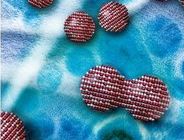
form and then attach to one another in solution
(Science, DOI: 10.1126/science.1219643). Such particle-level knowledge of nanocrystal growth should help scientists better control the synthesis and properties of nanomaterials.
De Yoreo’s team monitored the formation of iron oxy hydroxide nanoparticles. As small particles approach each other during synthesis, they orient so that their crystal lattices match. Once this happens, the tiny crystals accelerate toward one another and join. If small defects form during fusion, the particles shift afterward to fix them.
To see nanocrystals grow via particle-particle attachment, go to http://cenm.ag/grow.
Magnetic Bacteria May Be Building Future Bio-Computers
May 07, 2012
Magnet-making bacteria (Magnetospirillum) may be building biological computers of the future, researchers have said. A team from the UK's University of Leeds (Dr. Sarah Staniland) and Japan's Tokyo University of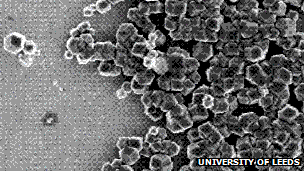 Agriculture and Technology (Dr. Masayoshi Tanaka) have used microbes that eat iron to perfect the magnetic particles that make up future hard drives.
Agriculture and Technology (Dr. Masayoshi Tanaka) have used microbes that eat iron to perfect the magnetic particles that make up future hard drives.
Furthermore, the researchers also managed to create tiny electrical wires from living organisms. They created nano-scale tubes made from the membrane of artificial cells, grown in a lab-controlled environment with the help of a protein present in human lipid molecules. "These biological wires can have electrical resistance and can transfer information from one set of cells inside a bio-computer to all the other cells." Besides computers, such biological wires could even be used in future for human surgery because they are highly biocompatible.
German Research Council (DFG) Establishes New Priority Program
May 01, 2012
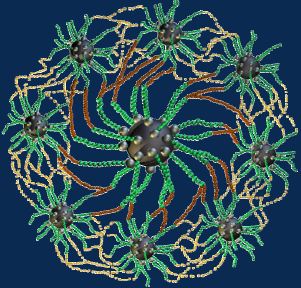
Within the frame of the initiative new multifunctional hybrid materials with a possibility for magnetic control will be in focus for the research activities. Such materials, consisting of a particulate magnetic component in a complex matrix exhibit a controllable material behaviour due to the interaction between particles and matrix. It will be the core interest of the programme to synthesise and understand the magnetic control of the material properties on the basis of a detailed understanding of the particle matrix interaction. Moreover the experimental analysis and multi scale modelling of the material will provide a basis to develop new applications for sensors and actors and to increase the efficiency of the biomedical application of magnetic nanoparticles by an enhanced knowledge about the interaction between tissue and functionalised particles.
Thus the programme will be borne by a highly interdisciplinary approach ranging from chemistry and physics towards engineering and medicine.
For more information, check out our Archives.
September 2017

Search this site with the power of

